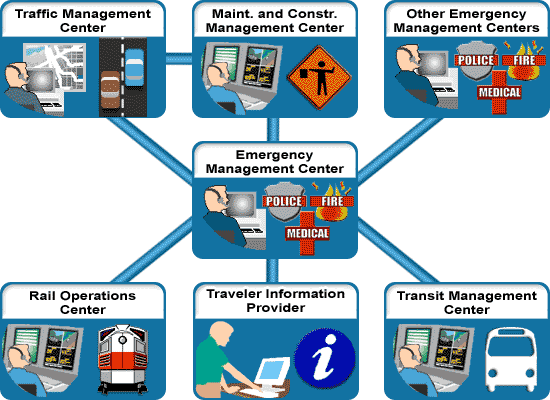Application Areas
Incident Management
Description
This center-to-center application area covers the interfaces that support the coordination and exchange of incident-related information between allied agencies. The interfaces support coordination of incident management among agencies, disseminate situation awareness and response plans to all agencies, and allow resources to be requested, tracked, and managed. In this context, incidents include all types of transportation-related incidents such as traffic accidents, planned roadway closures, and special events. This application area includes the following capabilities:- Coordinating with the traffic management center to coordinate closures, detours, and special access routes, and coordinate special traffic control strategies (e.g., emergency signal preemption).
- Coordinating with the traffic management center, maintenance and construction management center, and other public safety agencies to request and supply resources.
- Exchanging incident reports, incident status, and response coordination information between emergency response agencies.
- Obtaining real-time incident information from public safety call takers, including the nature and location of an incident.
- Providing incident information to the traveling public via the media and traveler information providers.
- Collecting information about the status of care facilities.
- Supporting local command of an incident.
- Coordinating information about hazardous materials between HAZMAT responders and HAZMAT shippers, carriers, and other HAZMAT information resources (e.g., CHEMTREC).

National ITS Architecture Interface
This application area focuses on the interfaces to the Emergency Management Subsystem (EM) that support incident management. The EM is notified of an incident from many sources including 911, eyes-on reports from the field, the Traffic Management Subsystem (TMS), and the Transit Management Subsystem (TRMS), Maintenance and Construction Management Subsystem (MCMS), and Rail Operations. Information about upcoming events is provided by Event Promoters. Response plans and resources are shared between the EM and other responding centers including other EMs, TMS, MCMS, TRMS, and Rail Operations. HAZMAT information is shared between the Fleet and Freight Management Subsystem and EM, representing information exchange between HAZMAT shippers, carriers, and HAZMAT responders. Traffic control strategies are coordinated between the EM and the TMS so that tailored traffic control strategies can be implemented to expedite the incident response and reduce the traffic impact of the incident. Care facility status is collected by the EM. As the incident response unfolds, updated incident information and incident response status is shared by the EM, which also disseminates incident information to Information Service Providers and the Media. Local incident command is supported by exchange of coordinating information between EMs. (Note that the interfaces to emergency vehicles are not covered in this set of interfaces, but are included in the center-to-vehicle/traveler application areas).Applicable Standards
In general, the following standards are applicable to Incident Management deployments. To determine which specific standards are applicable for a deployment you will need to determine which architecture flows will be needed for the Incident Management piece of your deployment. Contact your local FHWA ITS Division Specialist or an ITS Standards Program Field Support Team contact
Deployment Resources
Deployment resources can be found in the deployment resources
section.
- NTCIP Case study reports (1999-2004)
- IM (Incident Management) Standards Advisory
- NTCIP 9010 — XML in ITS Center-to-Center Communications
- Guide to the IEEE 1512 ® Family of Standards